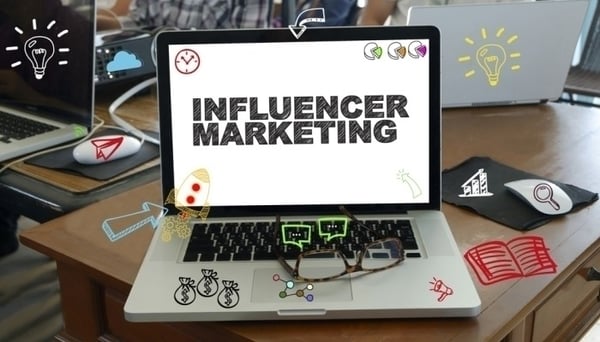Influencer marketing has been gaining traction at an increasing rate. It is no longer a "buzzword" or a marketing trend, today it has evolved into a full-fledged strategic approach for gaining visibility and acquiring reach for your brand and content.
So what might be the tactics for formulating an effective influencer marketing strategy for your campaigns?

In this article we will be covering the 10 steps you will need to take in order to formulate an influencer strategy for your business:
1. Define Your Goals and Objectives
Just like everything digital marketing, influencer marketing needs to start with a properly formulated goal. What is your niche? Who are influencers in that niche? What do you want to accomplish with this influencer? More importantly, how are you going to measure success?
If it is your first time attempting something like this, start small. Maybe don’t tackle the multi-million follower influencer in your niche, and expect high returns. To start off, micro-influencers might be the way to go, build up experience, and as you grow so should your expectations, and ultimately your goals.
2. Identify Influencers and Organize Them Into Three Tiers
Once you have set your goals and have identified the major players in your niche, it would be wise to segment them into categories (or tiers). For the sake of argument, let’s say that:
Category A: 1,000 - 25,000
Category B: 25,001 - 50,000
Category C: 50,001 - 100,000
Category D: Over 100,000
We all want to go after Category D influencers, they have the greatest following, the farthest reach, and could offer us the greatest visibility. While yes this is true, these influencers are often extremely busy and could potentially come at a very high cost.
Categories A and B is where you want to be, especially when starting up or are still inexperienced with influencer marketing (the influencers in this category can be characterized as micro-influencers.) While these individuals have a much smaller following than Category D, they are potentially also more narrow in their focus, and surprisingly more engaged with their audience.
Due to their size, their cost will also be much lower while having the potential for high results.
Category C is between the above categories we mentioned; see these as the next logical step of progression after Categories A and B but before Category D.
Whichever the case, be sure to target influencers that are properly engaged with their followers and are constantly active. While size does matter in this situation, you should care more about the quality of interaction.
3. Before Reaching Out, Start to Build a Relationship
Approaching and developing a relationship with influencers requires the same steps/building blocks as any other relationship. Influencers are not tools, they are human beings, so instantly emailing them with a business proposition or a pitch might have negative effects, ultimately putting them off.
You need to build trust, and nurture your relationship with them before any business related topics are mentioned. Show them you actually admire their work and success before ever talking shop.
Start by leaving a few comments on their blog posts and social channels to gain their attention, and potentially begin engaging with them. Another great thing you can do is to start sharing their content to your channels, while also stocking their ego.
The deeper the connection you create, the easier it will be to do business with them. Further, they will also show greater interest in you, and be more invested in your collaboration when the time comes.
4. Personalize Outreach
Continuing with the theme above, your approach needs to be personalized. Cookie cutter emails are often disregarded or seen as annoying when they are received. Just check out the last spam email you received.
It is the same way with influencers. Before reaching out, do some homework. Get to know what the influencer talks about, what they like, the type of audience they have etc. and then send out a personalized email in a friendly manner. Show them you appreciate their work and that you realize they are an authority in their niche.
Another important aspect of reaching out to an influencer is timing. Monitor channel activity and conversations, you want your email to also be relevant, and that it will warrant further engagement and conversation.
5. Tell Them Exactly What You Want Them to Do and What You’ll Do for Them in Return
So you’ve set your goals, found the influencers in your niche, and have initiated conversation with them. It is now time to talk business.
Present your proposition in a friendly but still professional manner, and lay down the goals and objectives for both sides. Honesty and transparency are key here.

Remember, influencer marketing works best if the individual is working with you, not for you. You spend time building a relationship and trust and now is the time to leverage it. Working with influencers needs to be a give and take relationship, being that it is mutually beneficial for both parties, not just you.
You will find that the above often leads to greater results than just hiring them to promote your product or brand. When you are working together, and the influencer is invested as well, monetary compensation often takes the back seat.
6. Create Requests, Not Demands
When the time comes to create content some creative liberty needs to be in place. Be sure to appropriately communicate what you envision the campaign and content to look like, but always ask for the influencer's 2 cents as well. Ask them what they would be interested in doing, what they would do differently, and what they think will work instead. Again this is a collaboration (a partnership), not an employer-employee relationship.
Of course, if there are certain things you really need to be done in a certain way, be careful in the way you ask. Create requests and help the influencer understand why things need to be done a certain way; don’t just demand it.
7. Give Them Access to Information, Events, and Experts
Just because you did your homework, does not mean that the influencer will always do theirs (or at least do it to the extent you did). In order to appropriately talk about and understand your brand and offering, they will need certain info. Be sure to empower them, and grant them access to all the necessary documentation for developing a holistic image. Things like as blog posts, white papers, e-books, press releases, case studies, etc. are all good examples of such documentation.
Note: In addition to knowing your brand better, this might also help the influencer be more invested in the project. Like we said above, you are creating a collaboration, you are helping the influencer see you as a partner rather than an employer or a client.
8. Allow Them to Be Themselves
Remember what we said about creative liberty above? It definitely ties to this point. Influencers are influencers because they have a certain authority, a certain character, and this carries over to the way they create content. Their audience follows them for this very reason, so it would be unwise to restrict them and take away from their “charisma”. Allow them to be themselves, to use their own words, voice, and tone.

9. Know Disclosure Requirements and Tell Them What They Need to Do
2017 set new standards when it comes to disclosing influencer marketing partnerships, so it is more important than ever to have complete disclosure by all parties involved. Be sure to include hashtags such as #sponsored, #promotion, # “company name”, or something along those lines.
Note: Be sure to check each post. Oftentimes, the influencer might have forgotten to add the proper disclosure, which is a big violation. If this is the case, kindly remind them to disclose any promoted content with your brand to avoid either party from getting penalized.
10. Think About Reporting
Sharing reports and analytics with each other is key to determining if the path you are currently on is the right one. See what currently is working, and try to spot any room for improvement with the influencer.
Tracking metrics in both the influencer and program levels is imperative for optimizing both parties’ approach and of course to evaluate the relationship accordingly. Finally, this can help both of you determine if the influencer’s audience is actually interested in what you have to offer. It would be wise to determine this early on, as it might potentially have negative effects for both parties if it is drawn out to the point of irritating followers.
Do you have any questions? Is there something we missed? Let us know!
And as always be sure to check out the links below for more digital marketing insight:
- 5 Steps to Unlocking the Power of Influencer Marketing
- Influencer Marketing [It Starts With This Step!]
- The 8 Step Influencer Marketing Strategy To Help You Get To The Top
- 5 Steps to Make Influencer Marketing Work for You



